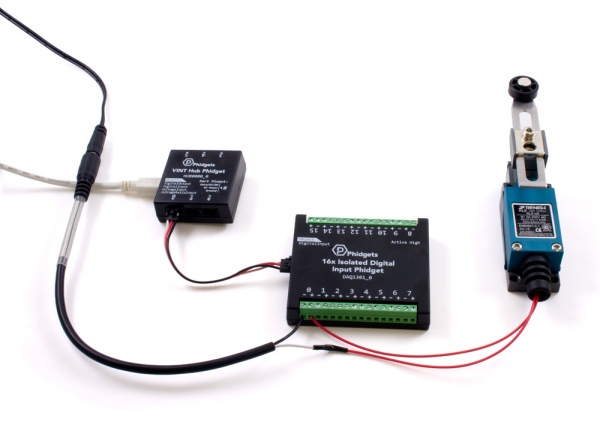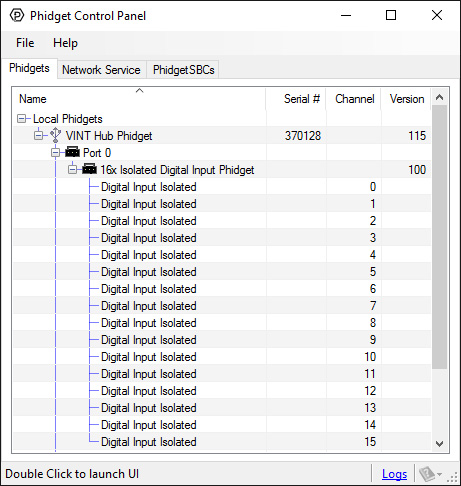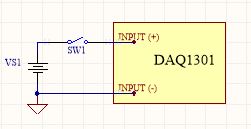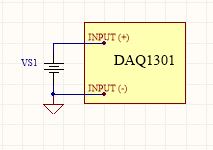DAQ1301 User Guide
Part 1: Setup
Welcome to the DAQ1301 user guide! In order to get started, make sure you have the following hardware on hand:
- DAQ1301 - 16x Isolated Digital Input Phidget
- VINT Hub
- Phidget cable
- USB cable and computer
- something to use with the DAQ1301 (e.g. switch, digital sensor with a digital output, etc.)
Next, you will need to connect the pieces:

- Connect the DAQ1301 to the VINT Hub using the Phidget cable.
- Connect the VINT Hub to your computer with a USB cable.
- Connect a switch or digital sensor to one of the DAQ1301's inputs.
Now that you have everything together, let's start using the DAQ1301!
Phidget Control Panel
In order to demonstrate the functionality of the DAQ1301, the Phidget Control Panel running on a Windows machine will be used.
The Phidget Control Panel is available for use on both macOS and Windows machines.
Windows
To open the Phidget Control Panel on Windows, find the ![]() icon in the taskbar. If it is not there, open up the start menu and search for Phidget Control Panel
icon in the taskbar. If it is not there, open up the start menu and search for Phidget Control Panel
macOS
To open the Phidget Control Panel on macOS, open Finder and navigate to the Phidget Control Panel in the Applications list. Double click on the ![]() icon to bring up the Phidget Control Panel.
icon to bring up the Phidget Control Panel.
For more information, take a look at the getting started guide for your operating system:
Linux users can follow the getting started with Linux guide and continue reading here for more information about the DAQ1301.
First Look
After plugging the DAQ1301 into your computer and opening the Phidget Control Panel, you will see something like this:

The Phidget Control Panel will list all connected Phidgets and associated objects, as well as the following information:
- Serial number: allows you to differentiate between similar Phidgets.
- Channel: allows you to differentiate between similar objects on a Phidget.
- Version number: corresponds to the firmware version your Phidget is running. If your Phidget is listed in red, your firmware is out of date. Update the firmware by double-clicking the entry.
The Phidget Control Panel can also be used to test your device. Double-clicking on an object will open an example.
Part 2: Using Your Phidget
About
The DAQ1301 has 16 digital input ports. This Phidget is best suited for reading switches, digital sensors, or external voltage signals up to 30V DC. The device's input-to-input isolation makes it great for projects that use multiple power sources.
The DAQ1301 is a high active device. You interact with the DAQ1301 through the Digital Input Channel Class. The Digital Input state equals false when grounded and true when connected to a high voltage.
Explore Your Phidget Channels Using The Control Panel
You can use your Control Panel to explore your Phidget's channels.
1. Open your Control Panel, and you will find the following channels:

2. Double click on a channel to open an example program. Each channel belongs to the Digital Input channel class:
In your Control Panel, double click on "Digital Input Isolated":

Part 3: Create your Program
Part 4: Advanced Topics and Troubleshooting
Before you open a Phidget channel in your program, you can set these properties to specify which channel to open. You can find this information through the Control Panel.
1. Open the Control Panel and double-click on the red map pin icon:

2. The Addressing Information window will open. Here you will find all the information you need to address your Phidget in your program.

See the Phidget22 API for your language to determine exact syntax for each property.
Note: Graphing and logging is currently only supported in the Windows version of the Phidget Control Panel.
In the Phidget Control Panel, open the channel for your device and click on the ![]() icon next to the data type that you want to plot. This will open up a new window:
icon next to the data type that you want to plot. This will open up a new window:

If you need more complex functionality such as logging multiple sensors to the same sheet or performing calculations on the data, you'll need to write your own program. Generally this will involve addressing the correct channel, opening it, and then creating an Event Handler and adding graphing/logging code to it.
The quickest way to get started is to download some sample code for your desired programming language and then search google for logging or plotting in that language (e.g. "how to log to csv in python") and add the code to the existing change handler.
Filtering
You can perform filtering on the raw data in order to reduce noise in your graph. For more information, see the Control Panel Graphing page.
Graph Type
You can perform a transform on the incoming data to get different graph types that may provide insights into your sensor data. For more information on how to use these graph types, see the Control Panel Graphing page.

To interface a switch with the DAQ1301, an external voltage source must be provided to pull the input HIGH.

The DAQ1301 can be used without additional circuitry to detect the presence of a voltage (up to 30V DC) on a line (from a power source or a signal). Do this by wiring the input terminals to the line and its corresponding ground.
